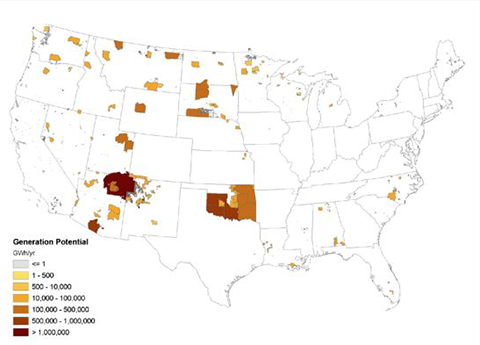Guidebook Explores Regulatory Barriers and Potential Solutions for Tribal Solar Projects
June 16, 2023 by Laura Beshilas
This blog summarizes a 2023 publication developed by NREL and the Midwest Tribal Energy Resources Association (MTERA) on regulatory challenges that Tribes face when pursuing solar projects.
Tribal land holds more that 5% of the solar photovoltaic potential in the United States, according to a 2013 report by NREL. However, this resource remains underutilized, and Tribes often cite regulatory hurdles to achieving their solar deployment goals.
In a three-year project funded by the U.S. Department of Energy's Solar Energy Technologies Office, NREL and MTERA set out to learn more about these regulatory barriers and explore potential solutions to the challenges Tribes face.
Through extensive engagement with Tribes, utilities, regulators, and other interested stakeholders, NREL and MTERA developed a three-part guidebook titled Addressing Regulatory Challenges to Tribal Solar Deployment.
What Is a Regulatory Barrier?
The report defines the regulatory process as any decision-making process that involves making rules that govern where, when, and how a solar project can be developed. Regulatory barriers are policy barriers and can exist at various scales including the utility-, local government-, tribal-, state-, regional-, and federal-level.
Most solar projects will encounter regulatory barriers of some kind. This project sought to address policy challenges or barriers that affect solar projects differently or disproportionately because they are located on Tribal land.
Guidebook Overview

The guidebook is presented in three parts:
-
Book One presents the regulatory challenges identified throughout the project and explores associated potential short- and long-term solutions.
-
Book Two includes a set of case studies of Tribal solar deployment projects or examples of policy solutions.
-
Book Three contains a set of "issue briefs" presenting details on issues that are uniquely relevant to solar deployment on Tribal land. Topics include Tribal sovereignty, Tribal business structures, utility-Tribal relationship building, and more.
Engagement Process
To learn about the regulatory barriers that challenge Tribal solar development, NREL and MTERA embarked on a three-year stakeholder engagement process. The team brought together more than 600 tribal, regulatory, utility, and other stakeholder groups to participate. Stakeholder engagement throughout the project was conducted in three main phases:
-
Information gathering: Gathered stakeholder information to shape the report through a baseline questionnaire, listening sessions, and one-on-one conversations.
-
Mid-project engagement and report development: Identified and ensured accurate communication of the barriers and draft recommended solutions through presentations, listening sessions, reviews by Tribal experts, and a mid-project questionnaire.
-
Report review and training: Shared findings with the stakeholder groups via summary documents, email, presentations, and one-on-one conversations.
Explore the Guidebook
Addressing Regulatory Challenges to Tribal Solar Deployment, NREL Technical Report (2023)
Addressing Regulatory Challenges to Tribal Solar Deployment: Key Findings, NREL Technical Report (2023)
Additional Resources
Addressing Regulatory Challenges to Tribal Solar Deployment Summary Slides, NREL Presentation (2023)
Midwest Tribal Energy Resources Association
NREL Decision Support for Tribes
Contact
If you have questions about this research, please contact Laura Beshilas.
Share

